The Gobi Desert is one of the largest and coolest deserts in the world. It incorporates a vast area between China and Mongolia.
A type of cold desert, it’s mostly a place of dunes and grassland. Animals still live even in this perceivably waterless habitat.
Some of the typical species in this desert include rodents and lizards. Some atypical species include camels and even bears.
The Gobi Desert offers some types of food for these animals such as plants, grasses, shrubs, seeds, and other animals. Since it sees snow, the desert is also home to migrating species.
Sedentary or migratory, some of the following species are the most representative of The Gobi Desert.
Table of Contents
1. Gobi Bear
One of the largest animals in The Gobi Desert, The Gobi Bear (Ursus arctos gobiensis) is a species that shows the tendency to eat plants first.
It feeds on fruit and various roots but it may also eat small rodents.

These bears aren’t actual predators of large mammals as the bears in other regions of the world.
Mostly brown and sometimes weighing as much as 250-300lbs, Gobi Bears are the only types of bears in the desert.
A unique species, the bear is almost extinct with less than 100 members still found in the desert today.
Mostly solitary, this bear is often too far from another one of its species to even begin breeding.
2. Gobi Racerunner

A type of multi-habitat lizard, The Goby Racerunner (Eremias przewalskii) is among the fast lizards of The Gobi Desert.
This is also a species that lives in other areas, showing adaptability and an alternation between diurnal and nocturnal feeding.
A bright base appearance is specific to these lizards. They have a bright yellow dorsum with black patterns and black spots.
White coloring is specific to its underbelly is which free of patterns.
This lizard shows a darker nuance head and a brighter nuance tail.
3. Wild Bactrian Camel

Wild camels still live in The Gobi Desert. While most Wild Bactrian Camels (Camelus ferus) are found in other areas, a population still exists in The Great Gobi.
This is a species that lives in groups and migrates in groups. Typical groups number at least 30 camels which are quickly identified based on their large size and double humps.
Wild Bactria Camel migrations show how they’re organized. A male leader is always in front of the pack and leads the rest of the camels, often finding places near water to rest.
Today, Wild Bactria Camel migrations are a rare sight since there are less than 1.000 of these camels left, with a risk of extinction.
4. Domestic Bactrian Camel

The Domestic Bactrian Camel (Camelus bactrianus), also called The Mongolian Camel, is one of the largest camels in the world.
Unlike The Wild Bactrian Camel, its domestic cousin is far from being extinct.
It’s believed that there are more than 2 million Domestic Bactrian Camels between China and Mongolia.
Also double-humped, this is a type of resilient camel that can face adversity such as cold weather. Long-distance human migration and transport have been linked to the species for a long time.
A migratory species that also live in The Gobi Desert, this is a species that spreads its range to Afghanistan.
From rocky mountain slopes to the dunes of the desert, this is the largest type of camel reaching a height of up to 5.9 feet.
5. Mongolian Wild Ass

Mongolian Wild Asses (Equus hemionus hemionus) are among the most widespread species of The Gobi Desert.
It feeds on grasses and vegetation in the desert as well as the desert steppe.
Mongolian Wild Asses are also considerably more numerous here than camels, bears, and even lizards since their populations exceed 40.000.
Some of their unique adaptations include the capacity to dig for water.
Mongolian Wild Asses survive the desert by digging in former river beds for water. Periods of long drought are thus easier to manage.
The species also shows the capacity to dig for water in other areas where they know water previously existed.
6. Mongolian Pit Viper

Venomous snakes are highly common in the world’s deserts. This is also the situation of The Mongolian Pit Viper (Gloydius intermedius), a highly venomous snake adapted to dunes.
This snake is active throughout the day and it may become inactive at noon, when the temperatures are at the highest.
Research on the potency of its venom is still limited. By some estimates, this is one of the most venomous snakes to be found in Northern China.
The snake can be identified by its flattened and slightly triangular head. It detects prey by temperature differences is senses the very small variation.
7. Gobi Ibex

The largest and the heaviest goat is also found in The Gobi Desert.
Gobi Ibexes (Capra sibirica) are a standalone species with a wide distribution at high altitudes. Its habitat spreads to West Asia and Northern India.
Generally living at an elevation of thousands of feet, this type of goat is also present in The Gobi Desert at elevations of several thousand feet.
Its range here is the lowest elevation the goat is found in as it prefers slopes in general and lower slopes for the coolest months.
There isn’t much vegetation this species can feed on in these difficult climates. It prefers to eat alpine plants and grasses specific to higher elevations.
8. Mongolian Wolf

Also a species of high elevations, Mongolian Wolves (Canis lupus chanco) have a widespread distribution in the desert with a wide habitat outside of the desert as well.
This type of wolf might be smaller than those in other areas of the world.
It’s still a fierce predator, hunting in packs. Its prey includes both small and large animals.
Some of its common choices involve hamsters, shrews, and badgers.
Larger prey offers larger meals and it’s the main reason Mongolian Wolves hunt down Siberian Ibexes, Mongolian Wild Asses, and even Bactrian Camels.
9. Mongolian Wild Horse
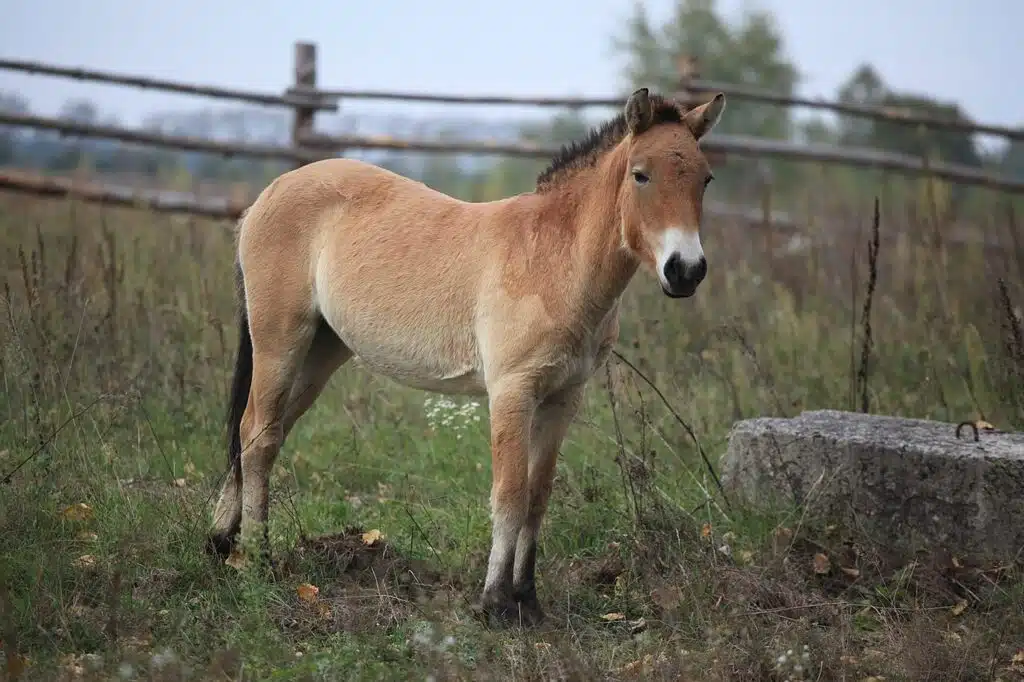
Smaller and more muscular than the domesticated horse, Mongolian Wild Horses (Equus ferus przewalskii) aren’t the ancestors of the domestic horse.
They run wild and live in a small area of The Great Gobi, typically in large numbers.
A stallion leads the group and often has to defend its position as a leader when challenged by members of other groups.
This happens in the spring, the typical breeding season for the wild horse.
Dietary choices include grasses that are in season with specific preferences each season.
While numerous, Mongolian Wil Horses often fall prey to The Himalayan wolf.
10. Mongolian Ground Jay
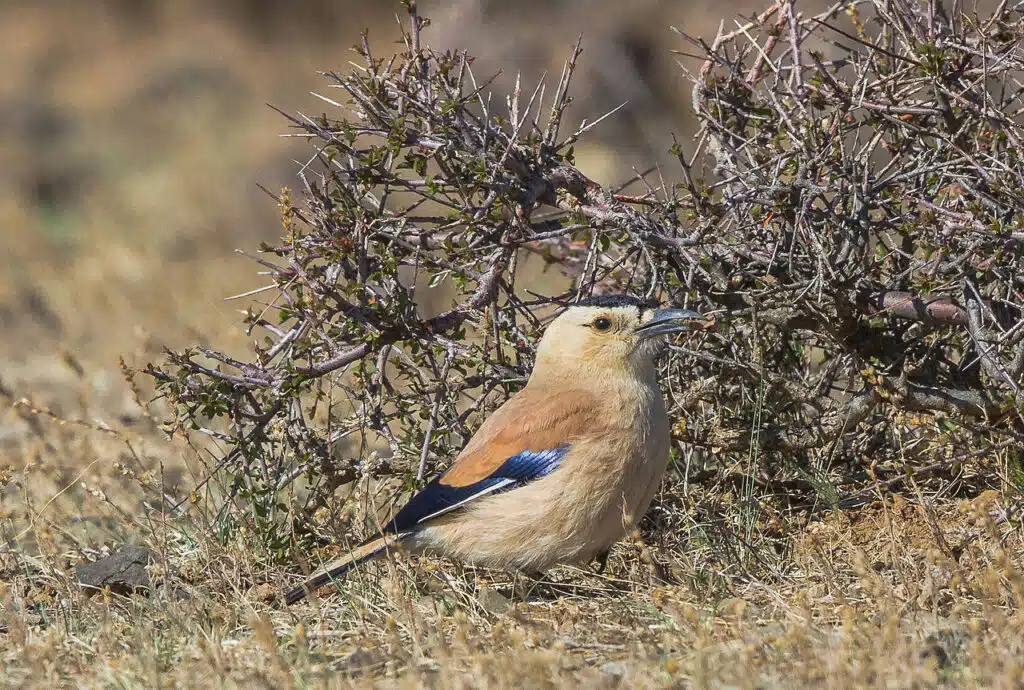
Small birds such as The Mongolian Ground Jay (Podoces hendersoni) survive The Great Gobi by feeding on lizards and invertebrates.
This species is dominated by earth nuance plumage.
A black tail and black-blue wings are specific to the species.
Its head has bright tan nuances with a black cap while its beak is long and slightly curved. A short black stripe behind the head is another distinct physical trait of these small birds.
11. Even-Fingered Gecko
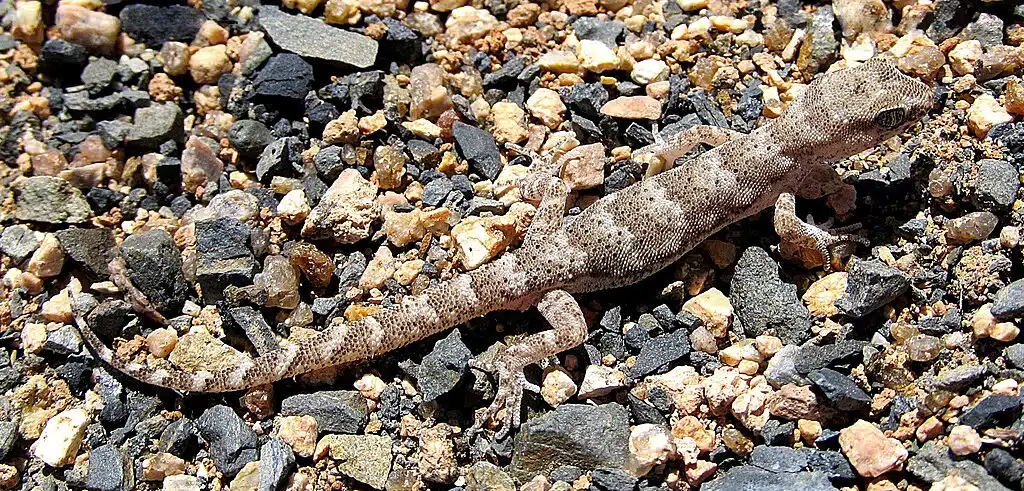
A species of The Great Gobi, Even-Fingered Geckos (Alsophylax pipiens) are small and wide lizards.
Living in the rocky areas of the desert, these lizards are dominated by a brown body and a wide brown tail.
Additional wave-shaped yellow interrupted stripes contrast its back, legs, and head.
Even-fingered Geckos are diurnal. They warm up in the sun and perch on rocks with the capacity to shed their tails if endangered.
12. Tuvan Toad-Headed Agama

Mostly found in China, Tuvan Toad-Headed Agama (Phrynocephalus versicolor) may resemble toad coloring.
Its patterns can change with the seasons and typically include a tan base color with black, white, and brown patterns across its dorsum.
Growing to a length of about 5 inches, Tuvan Toad-Headed Agamas are inactive for most months.
They are only seen during the summer, mainly in the morning and in the evening as they remain in burrows when the weather is too hot.
Surviving on ants and bugs, this is a species that enters a long hibernation and only becomes active in the spring in a period that lasts until early fall.
13. Desert Wheatear

A migratory species of The Gobi Desert, The Desert Wheatear (Oenanthe deserti) is a species that overwinters in Northern Africa.
It returns to the desert in the spring to breed.
This bright bird lives off insects it finds on the ground and shows typical desert and semi-desert earth nuances for its plumage.
Darker males show a black face, wings, and tail. Off-white to cream caps and dorsum are specific to males while the underbelly is also white.
Brighter females have similar nuances, black tails, but a bright brown head.
Like many species of the desert, these birds are mostly found in crevices or around rocky areas, ideal nesting places.
14. Black Kite

Black Kites (Milvus migrans) are found in The Gobi Deserts as well as in African Deserts, as a migratory species.
Smaller than Red Kites, this is a species that uses warm air currents next to cooler currents to glide in search of food.
It has wide adaptability in terms of food preferences as it feeds on small lizards, rodents, and even carrions.
Gliding is its specific hunting method but this species is also known to look for the eggs of other species which it can snatch when spotted without gliding.
Black Kites live long lives as they can survive up to 20 years.
15. Cinereous Vulture
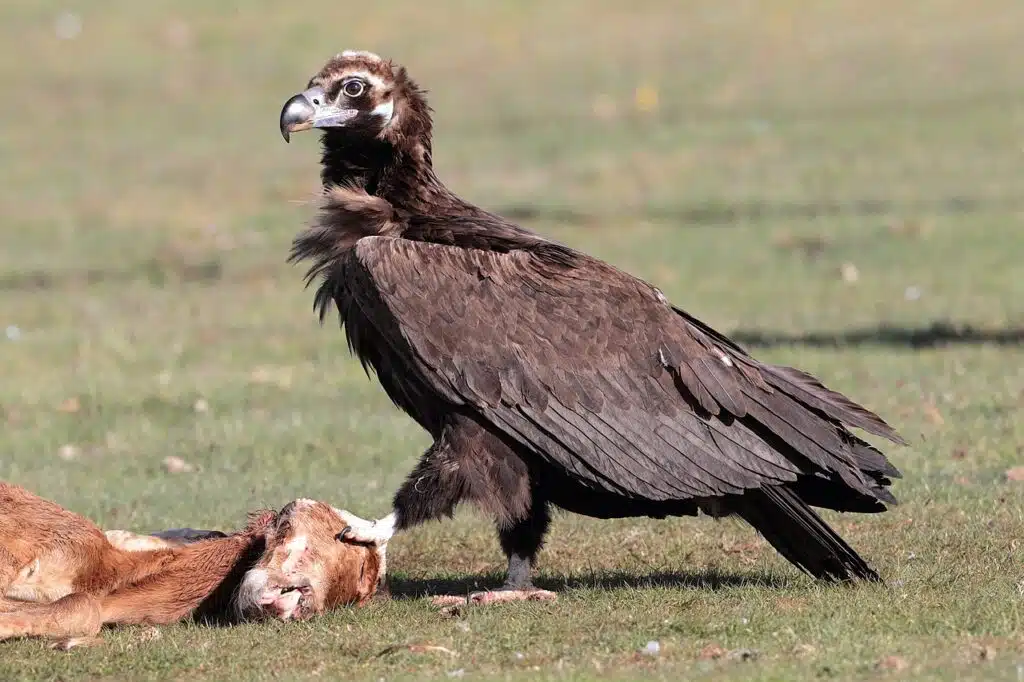
A large brown and black bird, The Cinereous Vulture (Aegypius monachus) lives in Europe and Asia, including in The Gobi Desert.
Its range is fragmented and it may be subject to small altitude changes depending on the season.
This is a bird that may move down to 2-4.000 feet in the summer.
Highly present in the desert, in China, and Mongolia, this species is very active, and it feeds on carrion.
This also makes it more vulnerable to diseases than many other species of The Gobi Desert.
It doesn’t live in groups, preferring solitary or pair living instead.
16. Pallas’s Sandgrouse

A buff-colored species, Pallas’s Sandgrouses (Syrrhaptes paradoxus) resemble pigeons in their shape and size.
These birds are found across Mongolia, in the desert, and steppes.
They need more water than other types of birds and are ready to travel long distances in the desert to find water sources to bask in.
Up to 70 miles are covered each day by the moving Pallas’s Sandgrouse for water.
Their relationship with water is crucial in an area such as the desert.
Plumage of these birds is soaked into water to offer some moisture to their young, back in the nest.
17. Tolai Hare
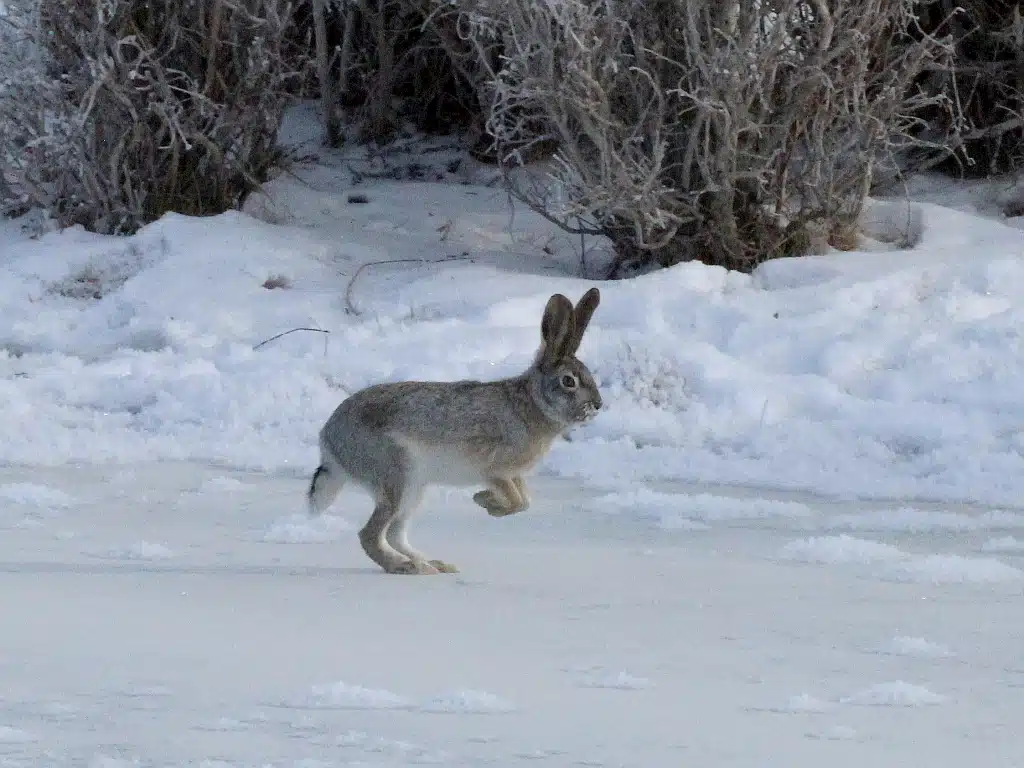
A species that breeds multiple times per year, Tolai Hares (Lepus tolai) are common in The Great Gobi and in East Asia.
This hare species comes in different colors such as gray, brown, and yellow.
Its coloring varies considerably, as do its habits. Feeding on grasses, this hare only digs slightly into the ground as it doesn’t live in burrows.
It creates a slightly lower place to overnight, digging a bit deeper in the winter.
These hares are found around rocky areas and areas of the desert with vegetation.
18. Bearded Vulture

With a wingspan of over 9 feet, Bearded Vultures (Gypaetus barbatus) are some of the largest birds of The Great Gobi.
This is a species that has a white head and brown wings, covering long distances but not migrating in the desert.
Its feeding habits include carrion as well as different types of lizards within the desert.
A solitary species Bearded Vultures are often hunted and are considered almost extinct outside their Eastern Asian territories.
Found in areas with cliffs and rocks, this is a vulture that also has a presence in other deserts of the world, such as The Negev Desert.
19. Mongolian Pika

Gray or gray-brown, the round-shaped Mongolian Pika (Ochotona pallasi) is an important species in the desert.
Feeding on plants helps disperse seeds to ensure vegetation can grow in new areas of its rocky habitat.
This is also one of the few species in The Gobi Desert to keep a stash of food for the winter.
Mongolian Pikas take grasses to their hiding locations which they later consume in the winter.
As a result, in areas of the desert with large and small rocks The Mongolian Pika is found as these are ideal hiding spots for its dry grasses to consume in the winter, a period when the pika also gets darker.
20. Upland Buzzard
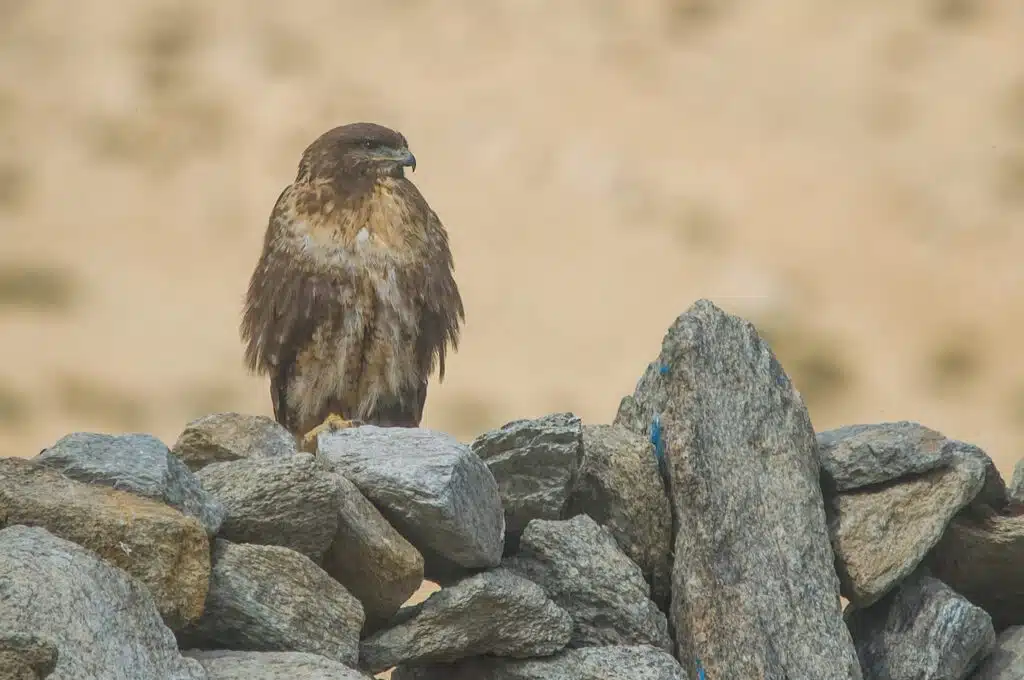
Upland Buzzards (Buteo hemilasius) are mostly common in The Great Gobi, in Mongolia, and Northern China.
This species lives and breeds here, only migrating for the winter. Low wintertime food accessibility may make the species migrate over short distances.
Much of his days are spent looking for food. They are known to eat small rodents.
Pikas and voles are among its favorites. It even finds these rodents at higher elevations.
True predators, also eat small birds such as jays and finches, but not as commonly.
21. Saker Falcon

Brown, white, and black, Saker Falcons (Falco cherrug) are some of the darker birds of The Greater Gobi.
Their presence here overlaps the breeding range of the species and it’s one of the main reasons the bird is important to local Mongolian culture as a national bird.
This is also a fast species, reaching some of the highest flying speeds in the world of birds.
Saker Falcons are further known for eating rodents they can find in the desert, rather than hares and larger prey.
Small birds may also be on their diet list. While a protected species, Saker Falcons may also suffer from population decline due to being hunted.
22. Common Raven

Common Ravens (Corvus corax) are some of the typical species of The Gobi Desert found around the world, even in other deserts.
From The Great Gobi to The Mojave Desert, Common Ravens are resourceful and can live in different climates, even at high elevations.
The Tibetan Common Raven even lives at an elevation above 10,000 feet.
Black birds of this species eat carrion, plants, grains, grasses, and insects they can easily find in the desert.
Living in large groups, they can also mix with other local birds which they can outcompete when it comes to access to food.
23. Mongolian Toad

Mongolian Toads (Strauchbufo raddei) are highly common in The Great Gobi, as well as through Northeast Asia.
These types of toads are green and dark green, reaching a size of up to 3.5 inches.
They prefer sandy soils as they can easily burrow here and because they easily find food here.
Mongolian Toads burrow to escape the high summer heat and survive these arid conditions by eating ants.
Alternatively, these types of toads may also eat small spiders.
Toads of the species live in a widespread habitat at medium elevation, but always above 2.000 feet.
24. Chukar Partridge

Feeding on seeds and insects, Chukar Partridges (Alectoris chukar) are among the birds with a high presence in Mongolia.
This species can live in deserts as well as at high elevations. It has been introduced around the world as a game species due to its high adaptability.
Brown, gray, black, and yellow, these birds feature a distinct red beak and black bands around the eyes.
They have striped wings and can be further identified by a rather round body shape, typical of the pheasant family.
Chukar Partridges are mostly active during the summer breeding season.
These small birds are also very loud and known for their repetitive calls with vocalizations for different events or different reactions.
25. Great Gerbil

Great Gerbils (Rhombomys opimus) are part of a small group of animals of The Great Gobi that store food for the winter.
They live in large underground burrows where they store plants and seeds for later consumption.
Unlike hares or even other rodents, Great Gerbils dig large burrows where they live, breed, and store food.
Multiple rodents share the same burrow and are typically part of the same family.
These burrows are complex, with tunnels and chambers for both the rodents themselves and for the food they bring back here.
Great Gerbils are an important food for vultures and snakes in The Gobi Desert.
Finding these types of rodents in the desert is not difficult for vultures and other prey birds.
Excavated earth traces are found above the ground as they dig their burrows. Birds and snakes guide themselves by this extra soil to locate their burrows.
A yellow-orange color is specific to these rodents which can be spotted outside of the burrow during the day.
They rarely venture out on their own as Great Gerbils are highly social, living in small groups for life.
26. Mongolian Finch

The Great Gobi marks the Eastern limit of Mongolian’s Finches (Bucanetes mongolicus) range. East Turkey marks its Eastern limit to its widespread habitat.
These birds are colorful and display some differences between males and females across the body.
Males are colorful with brown, gray, and even pink nuances. Small pink sections are seen on the underside of the male Mongolian Finch.
Dark brown and black areas are specific to its wings while the head is gray-brown.
Females are mostly gray and while they also have pink spots on the underside, these are faded spots that are barely visible.
Mongolian Finches live in small flocks, feeding on plants and seeds.
They are highly active during the summer season when they breed.
This is also the only period of the year when the Mongolian Finches are heard with their sharp vocalizations.
27. Arrow Snake

Ground-color snakes are often found in the desert. Arrow Snakes (Psammophis lineolatus) are among the multiple species with a sand color of a tan nuance.
This is a species with many types of patterns. Stripes are the most common across its dorsum.
Black, brown, and even white stripes are seen on the snake. There are 2 stripes on each side of its dorsum.
Its tail shows a different pattern which includes brown bands.
The species can also be seen in an interrupted stripe pattern or even in a stripe-free pattern.
Arrow Snakes are mildly venomous. They can use this venom against small prey but it’s not believed to be a life-threatening type of venom to humans.
All of its morphs show a white underbelly with large scales.
The most active period for the snake includes June and July, a time when the female lays eggs in burrows.
This sand-liked-colored snake can grow to a size of 20-30 inches as an adult.
28. Mongolia Rock Agama
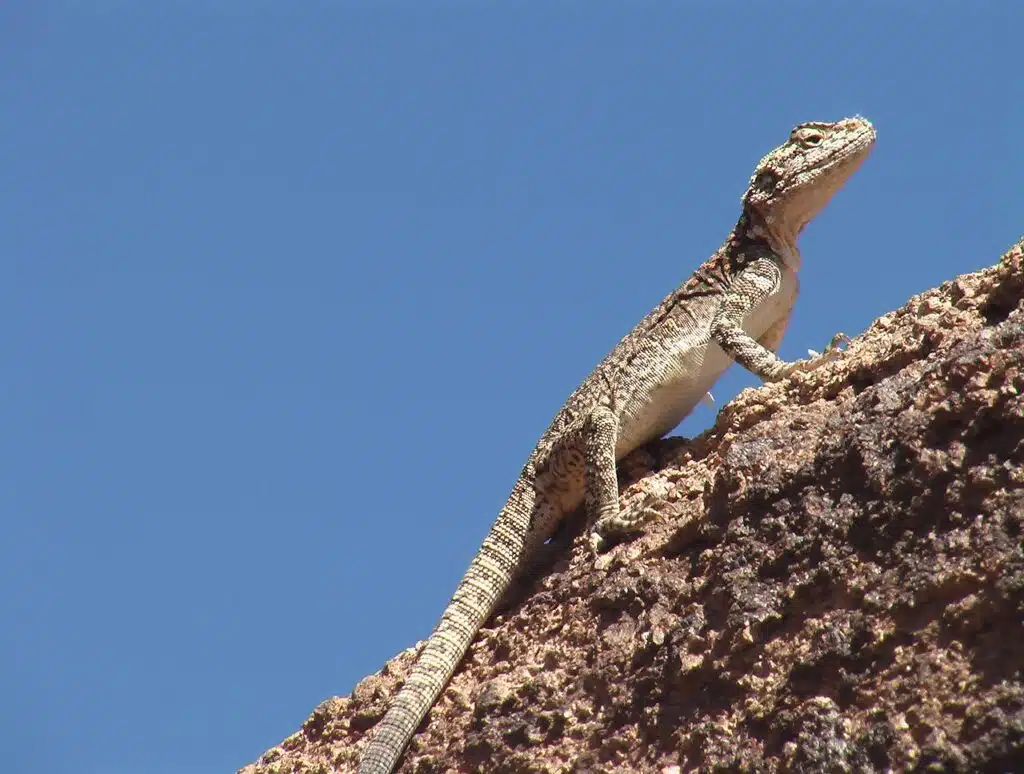
Mongolia Rock Agamas (Paralaudakia stoliczkana) are among the species of The Gobi Desert that live in rocky areas.
These types of lizards also live in the forest of Northern China but are as present in the desert.
As most species of lizards and animals here, they prefer rocky areas as they are likely to show plant growth and to attract insects such as ants.
The species doesn’t take the appearance of rocks, on the other hand.
Mongolia Rock Agamas have a dark appearance showing dark olive, dark brown, or even black ground colors.
Yellow stripes and patterns are specific to their dorsum, tail, legs, and head.
These types of lizards can be further identified by their mostly black tails as they only show yellow patterns at the base of the tail, the region closest to their body.
29. Gobi Big Brown Bat

A type of bat that feeds on insects, Gobi Big Brown Bats (Eptesicus gobiensis) grow to 2.6 inches.
Native to Central Asia, they are also found in The Great Gobi, where they eat insects. They are also believed to eat butterflies in other areas of their range.
Gobi Big Brown Bats are adaptable and can live in semi-desert climates, forests, and steppes.
The range of these bats is extensive even outside of The Great Gobi Desert.
Northeastern Russian territories mark the Northern limit of its range while India marks the Southern limit of its range.
Highly common in China and Mongolia, this type of bat expands Eastwards to Afghanistan.
30. Gobi Jerboa
Of all rodents of The Gobi Desert, The Gobi Jerboa (Allactaga bullata) is the species that like this habitat the most.
A bright species that lives alone, this is a type of rodent that is active throughout the year.
It lives in burrows where it spends its days to come out for food at night.
Most of its burrows are found in sandy soil next to plants, flowers, and bushes. It digs its burrows here as these are also the plants that attract its favorite insects.
Young and adult beetles are part of its diet, which is mostly based on the seeds of various flowering plants.
Its deep burrows located next to these types of plants are only used for resting as the species doesn’t store food as others.
Outside of the desert, the species also lives in temperate grasslands in Northern China. It burrows less here outside of its sand-dominating habitats.